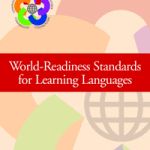
First published in 1996 as the Standards for Foreign Language Learning, the World-Readiness Standards for Learning Languages represent an unprecedented consensus among educators, business leaders, government, and the community on the definition and role of language instruction in American education. This document has been used by teachers, administrators, and curriculum developers at both state and local levels to begin to improve foreign language education in U.S. schools. In addition, they have provided the basis for national initiatives such as standards for teacher education programs, as well as for National Board Certification.
ACTFL director of Education, Paul Sandrock, comments, “With the emphasis in every discipline on college and career readiness, these new Standards for learning languages directly lead development of stronger literacy for all learners, K-16, with the added value of world-readiness. Language learners deal with using multiple strategies to make meaning and express themselves, expanding their literacy strategies while also learning to communicate and interact with and within other cultures.”
According to Sandrock, “These refreshed standards are familiar in their organization around the original five goal areas, but the descriptors point to what is new, identifying the critical thinking skills and creativity that one needs to acquire a new language.” Sandrock continues, “The 21st century learner faces a future of work that increasingly requires collaboration and communication with people from other cultures, whether on a local assembly line or in a boardroom across the globe. What better preparation than to experience firsthand how language functions and how cultures influence each other? That is the language classroom or virtual learning environment envisioned by these new standards.”


